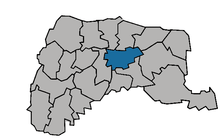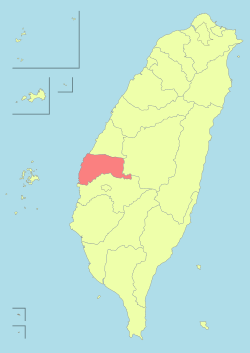Huwei, Yunlin
Coordinates: 23°43′12″N 120°26′07″E / 23.719983°N 120.435364°E


.jpg)
Huwei Township (Chinese: 虎尾鎮; pinyin: Hǔwěi Zhèn; Pe̍h-ōe-jī: Hó͘-bóe-tìn or Hó͘-bé-tìn) is an urban township in Yunlin County, Taiwan. It has a population of about 70,269.
Name
In the 17th century, during the Dutch era, Favorolang was one of the largest and most powerful aboriginal villages in Taiwan.[1] The name has also been spelled Favorlang, Favorlangh, and Vovorollang.[2] Its location was north of Tirosen (modern-day Chiayi), and the Favorlang river had been called by the Chinese How-boe-khe (吼尾溪) during the reign of the Qing Yongzheng Emperor (ca. 1722 – 1735). The Chinese called the area 大崙腳庄 and later renamed it to 五間厝庄 (Pe̍h-ōe-jī: Gō͘ -keng-chhù-chng).[3]
The name Favorlang is said to have derived from the ethnonym Babuza,[4] a tribe of the Taiwanese Plains Aborigines.
In 1920, during Taiwan's Japanese era, the name was modified to 虎尾 (officially, Kobi Town (虎尾庄), under Kobi District (虎尾郡), Tainan Prefecture). During this era, the town earned the nickname of "Sugar Capital" (糖都).
Government
Administrative divisions
|
|
Local government
Economy
- Huwei Sugar Factory
Education
Tourist attractions
- Huwei Sugar Factory Iron Bridge
- SL Towel Industrial Tourism and Explore Factory
- Tongxin Park
- Yunlin Hand Puppet Museum
- Yunlin Story House
Famous residents
See also
| Wikimedia Commons has media related to Huwei Township, Yunlin County. |
References
- ↑ Andrade, Tonio (2005). "Chapter 7: The Challenges of a Chinese Frontier". How Taiwan Became Chinese: Dutch, Spanish, and Han Colonization in the Seventeenth Century. Columbia University Press.
- ↑ Campbell, William (1903). "Explanatory Notes". Formosa under the Dutch: described from contemporary records, with explanatory notes and a bibliography of the island. London: Kegan Paul. p. 542. OCLC 644323041.
- ↑ 楊彥騏 (2003). 虎尾的大代誌 (in Chinese). Yunlin: 雲林縣政府文化局. ISBN 9789570138382.
- ↑ Li, Paul Jen-kuei (2003). "Introduction: Notes on Favorlang, an Extinct Formosan language". In Ogawa, Naoyoshi. English-Favorlang vocabulary. Tokyo: Research Institute for Languages and Cultures of Asia and Africa. pp. 1–13. ISBN 4872978536.
- ↑ http://www.huwei.gov.tw/english/content/index.asp?m=1&m1=15&m2=62&gp=59
- ↑ http://uld.judicial.gov.tw/indexen.asp
External links
- Huwei Township Office (English)
| |||||||||||||||||||||
